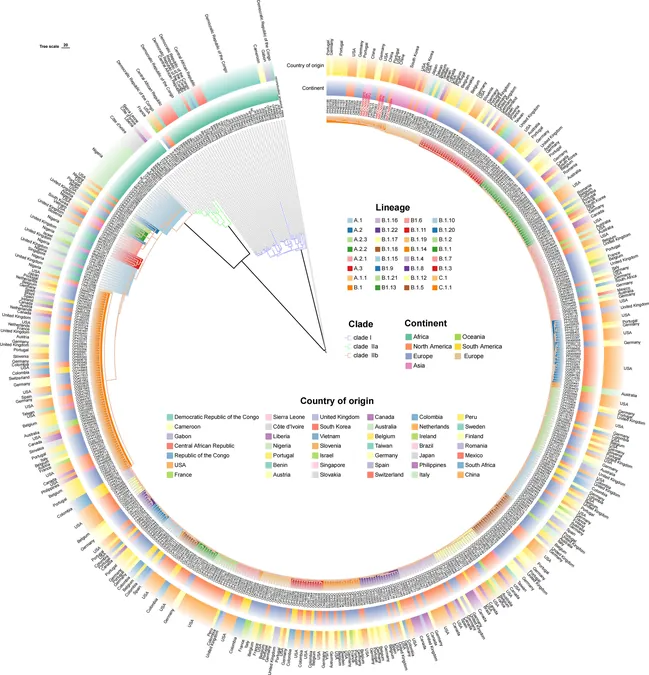
Monkeypox Virus Evolutionary Variation Identified in Nantong, Jiangsu: A Cause for Global Concern!
2024-12-23
Author: Wei Ling
Monkeypox Virus Evolutionary Variation Identified in Nantong, Jiangsu: A Cause for Global Concern!
In a striking development, a variant of the monkeypox virus (MPOX) has been detected in Nantong City, Jiangsu province, marking a significant milestone in the virus's evolutionary history. This rare zoonotic disease, caused by the monkeypox virus (MPXV), presents symptoms reminiscent of smallpox but generally manifests in a milder form, characterized by fever, myalgia, lymphadenopathy, and vesicular lesions.
Understanding the Monkeypox Virus
MPXV is a double-stranded DNA virus belonging to the Orthopoxvirus genus, which encompasses smallpox and cowpox viruses. The virus's genome comprises approximately 197 kilobases, featuring essential genes responsible for replication and immune evasion. Genomic surveillance has become increasingly vital as MPXV incidences rise in non-endemic countries, triggering worldwide efforts to understand its epidemiology and mutation patterns.
Recent Discoveries in Nantong
Recent genomic sequencing has revealed that the MPXV cases in Nantong belong to Clade IIb, a lineage linked to the global MPOX outbreak that began in 2022. Notably, six out of seven identified cases from this region show potential connections to lineage C.1.1. The emergence of this lineage adds complexity and concern, as it suggests a potentially novel route of transmission influenced by social behaviors, particularly among men who have sex with men (MSM).
While the initial symptoms in these individuals were mild, complete genome sequencing exhibited notable variations that might indicate increased transmissibility or altered pathogenic characteristics. This development underscores the need for vigilance and informed public health responses.
Historical Context and Global Spread
The first identification of MPXV dates back to 1958 in laboratory monkeys, with the first human case emerging in the Democratic Republic of Congo in 1970. Following smallpox eradication, immunity to Orthopoxviruses decreased, leading to increased MPOX endemicity in Africa. The global outbreak from 2022 to 2023 raised alarms, particularly as cases spread rapidly among communities with no travel history to endemic regions.
In Nantong, local epidemiological investigations confirmed that the contagion spread primarily through close physical contact, reflecting patterns also observed in other parts of the world. Two of the patients frequented high-risk venues in Shanghai, emphasizing the need for enhanced public awareness and preventive measures.
The Genetics Behind the Outbreak
Genomic analysis conducted on samples from Nantong revealed critical mutations within the MPXV genome, including those in proteins essential for viral replication and immune modulation. These findings suggest serious implications for vaccine effectiveness and treatment strategies.
The emergence of new lineages and mutations showcases MPXV's ability to adapt, which poses challenges for containment and control measures globally. Therefore, extensive genomic research and real-time surveillance are imperative to monitor the evolution of MPXV and its transmission pathways.
Future Directions
The findings from Nantong point to a pressing need for enhanced genomic databases and more extensive monitoring to understand fully and combat the ongoing threat of MPOX. Research efforts should focus not only on surveillance but also on the development of more effective vaccines and treatments.
In conclusion, the detection of monkeypox virus evolutionary variations in Nantong is a crucial development that calls for an immediate and unified global response. All stakeholders must prioritize understanding this evolving pathogen to ensure public health safety across the globe. Will we see more changes in this virus that could affect our lives? Only time will tell, but vigilance is of the essence!
 Brasil (PT)
Brasil (PT)
 Canada (EN)
Canada (EN)
 Chile (ES)
Chile (ES)
 España (ES)
España (ES)
 France (FR)
France (FR)
 Hong Kong (EN)
Hong Kong (EN)
 Italia (IT)
Italia (IT)
 日本 (JA)
日本 (JA)
 Magyarország (HU)
Magyarország (HU)
 Norge (NO)
Norge (NO)
 Polska (PL)
Polska (PL)
 Schweiz (DE)
Schweiz (DE)
 Singapore (EN)
Singapore (EN)
 Sverige (SV)
Sverige (SV)
 Suomi (FI)
Suomi (FI)
 Türkiye (TR)
Türkiye (TR)